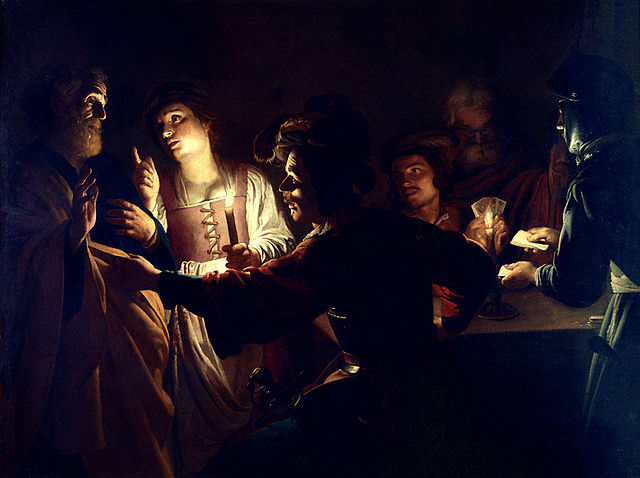The Denial of St Peter
Looking back on my POTM history I noticed that they are all either British or Italian in origin. There is a warning on the homepage about my preferences, but I actually like a lot of other stuff, so for June I have made a conscious effort not to be predictable. Gerard van Honthorst (or Gerrit van Honthorst) (1592 – 1656) was a Dutch artist of the Dutch Golden Age. The majority of the of the 17th Century in the Dutch Republic was an era of industry, trade and wealth that resulted in a sort of cultural and intellectual Renaissance. Jan Vermeer and Frans Hals come to mind when thinking of painters of this time; images of domestic harmony, patriotic landscapes and scenes of celebration (usually set in a tavern). In a lot of paintings you see a fusion of that typical Flanders realism and an infiltration of the Italian Baroque, a mix which van Honthorst uses to full effect.
The Denial of St Peter (1612-20), done when the artist was in his twenties we can see a strong sense of his influences, before he developed an idiosyncratic style. The expansion of international trade resulted in the trading of ideas, and what with the increasingly popular circulation of prints and books paintings by Renaissance masters could be seen without visiting Italy. In Utrecht a following of Caravaggio called the Caravaggisti were inspired by the artist’s originality and began adopting his style for their own works. I think that the Caravaggio’s use of realism was something that appealed to the Dutch artistic culture which very much rooted in landscape and still life. The elements borrowed from the master in this painting are obvious, most notably that strong tenebrism synonymous with Caravaggio. An impenetrable blacky/brown darkness dominates the canvas. What details have been picked out with light are highly realistic and have a sort of earthy natural quality. There is a directness about the subject at hand and we are immersed in the scene, which appears to be set in a tavern. The use of candlelight became a sort of emblem for the Caravaggisti, notably in works by Georges de la Tour. If I am correct Caravaggio never included a candle in his works, and in addition his use of light is not like that emitted by a candle, it is starker and directional like a spotlight. Irrelevant of this it creates such a high contrast of light and dark, giving the image warmth and intimacy, it feels like we are included in something secret.
The six figures in the painting are composed in a sort of zigzag, and we can read the scene from left to right. The story from the New Testament describes how Peter is accused by a young maidservant (the first two figures) of knowing Jesus, which in fear of his life he denies. As predicted by Christ he does this three times, after which he repents. Peter is an old man, white haired, bearded with a wrinkled brow. He holds his right hand up in a gesture of innocence, simultaneously resembling a blessing, while his left rests over his heart as if taking an oath. You can imagine what he is saying in his defence, exclaiming that he doesn’t know what the girl is talking about, swearing it. The servant girl leans towards Peter, pointing an accusatory finger which directs our eye to the Apostle’s dramatically lit face, his eyebrows raised in shock. Her other hand holds one of the two candles, the light sources of the painting, creating a circle of light around herself, Peter and the next figure. It also uplights her face and chest, revealing her tight bodice and dirtied apron. The man beside her is obviously an authority of some kind, a guard or sheriff perhaps. He is dressed in fashionable contemporary clothes, a sheathed sword at his side and the hint of a plume in his hat. He is in mid-movement, one hand helping to push him up from the table while the other grasps at Peter’s yellow toga-like shawl (Peter is the only one in historic costume it seems). The colour yellow is symbolic of duplicity and cowardice, traditionally associated with Judas Escariot (see Giotto‘s 1305 fresco Kiss of Judas). The other three people in the painting sat around a table, where two are playing cards. One of them has noticed the commotion going on, and the bearded man at the back has taken the opportunity to check out his hand. The last figure whose back is turned to us, presumably in cahoots with the shady figure, curiously wears a helmet. Maybe he is a knight, not reflected in his behaviour. In these two groups we have a division of the scene, curiously emulating two of Caravaggio’s paintings; firstly the The Denial of St Peter (1610) and secondly The Cardsharps (c.1594).
Van Honthorst had visited Rome and would have seen Caravaggio’s works in the flesh, which clearly had a massive impact on his own work. In fact while he was there he stayed with Vincenzo Giustiniani, a prominent art collector and once patron of Caravaggio. He went on to became one most famous of the Caravaggisti, and the inspiration of the Italian master proved to be a lasting one.

